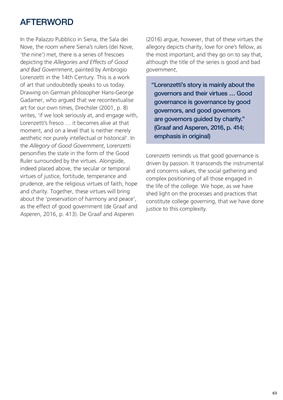
63
In the Palazzo Pubblico in Siena, the Sala dei
Nove, the room where Siena's rulers (dei Nove,
'the nine') met, there is a series of frescoes
depicting the Allegories and Effects of Good
and Bad Government, painted by Ambrogio
Lorenzetti in the 14th Century. This is a work
of art that undoubtedly speaks to us today.
Drawing on German philosopher Hans-George
Gadamer, who argued that we recontextualise
art for our own times, Drechsler (2001, p. 8)
writes, 'if we look seriously at, and engage with,
Lorenzetti's fresco … it becomes alive at that
moment, and on a level that is neither merely
aesthetic nor purely intellectual or historical'. In
the Allegory of Good Government, Lorenzetti
personifies the state in the form of the Good
Ruler surrounded by the virtues. Alongside,
indeed placed above, the secular or temporal
virtues of justice, fortitude, temperance and
prudence, are the religious virtues of faith, hope
and charity. Together, these virtues will bring
about the 'preservation of harmony and peace',
as the effect of good government (de Graaf and
Asperen, 2016, p. 413). De Graaf and Asperen
(2016) argue, however, that of these virtues the
allegory depicts charity, love for one's fellow, as
the most important, and they go on to say that,
although the title of the series is good and bad
government,
Lorenzetti reminds us that good governance is
driven by passion. It transcends the instrumental
and concerns values, the social gathering and
complex positioning of all those engaged in
the life of the college. We hope, as we have
shed light on the processes and practices that
constitute college governing, that we have done
justice to this complexity.
AFTERWORD
"�Lorenzetti's�story�is�mainly�about�the�
governors and their virtues … Good
governance�is�governance�by�good�
governors, and good governors
are�governors�guided�by�charity."�
(Graaf�and�Asperen,�2016,�p.�414;�
emphasis�in�original)